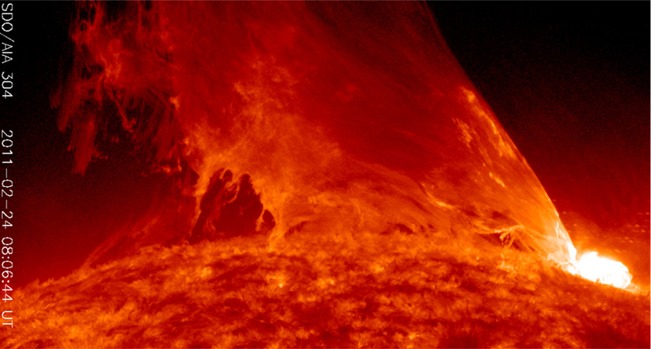NetNews
Super Solar Flares Are Overdue: Mass Nuclear Plant Meltdowns Will Happen
by Matthew Stein/Truthout
There are nearly 450 nuclear reactors in the world, with hundreds more being planned or under construction. There are 104 of these reactors in the United States and 195 in Europe. Imagine what havoc it would wreak on our civilization and the planet’s ecosystems if we were to suddenly witness not just one or two nuclear meltdowns, but 400 or more! How likely is it that our world might experience an event that could ultimately cause hundreds of reactors to fail and melt down at approximately the same time? I venture to say that, unless we take significant protective measures, this apocalyptic scenario is not only possible, but probable.
Consider the ongoing problems caused by three reactor core meltdowns, explosions and breached containment vessels at Japan’s Fukushima Daiichi facility and the subsequent health and environmental issues. Consider the millions of innocent victims who have already died or continue to suffer from horrific radiation-related health problems (“Chernobyl AIDS,” epidemic cancers, chronic fatigue, etcetera) resulting from the Chernobyl reactor explosions, fires and fallout. If just two serious nuclear disasters, spaced 25 years apart, could cause such horrendous environmental catastrophes, it is hard to imagine how we could ever hope to recover from hundreds of similar nuclear incidents occurring simultaneously across the planet. Since more than one-third of all Americans live within 50 miles of a nuclear power plant, this is a serious issue that should be given top priority.[1]
In the past 152 years, Earth has been struck by roughly 100 solar storms, causing significant geomagnetic disturbances (GMD), two of which were powerful enough to rank as “extreme GMDs.” If an extreme GMD of such magnitude were to occur today, in all likelihood, it would initiate a chain of events leading to catastrophic failures at the vast majority of our world’s nuclear reactors, similar to but over 100 times worse than, the disasters at both Chernobyl and Fukushima. When massive solar flares launch a huge mass of highly charged plasma (a coronal mass ejection, or CME) directly toward Earth, colliding with our planet’s outer atmosphere and magnetosphere, the result is a significant geomagnetic disturbance.
The last extreme GMD of a magnitude that could collapse much of the US grid was in May of 1921, long before the advent of modern electronics, widespread electric power grids, and nuclear power plants. We are, mostly, blissfully unaware of this threat and unprepared for its consequences. The good news is that relatively affordable equipment and processes could be installed to protect critical components in the electric power grid and its nuclear reactors, thereby averting this “end-of-the-world-as-we-know-it” scenario. The bad news is that even though panels of scientists and engineers have studied the problem, and the bipartisan Congressional electromagnetic pulse (EMP) commission has presented a list of specific recommendations to Congress, our leaders have yet to approve and implement any significant preventative measures.
Most of us believe that an emergency like this could never happen, and that, if it could, our “authorities” would do everything in their power to prevent such an apocalypse. Unfortunately, the opposite is true. “How could this happen?” you might ask.
Nuclear Power Plants and the Electric Power Grid
Our current global system of electrical power generation and distribution (“the grid”), upon which our modern lifestyles are utterly dependent, is extremely vulnerable to severe geomagnetic storms, which tend to strike our planet on an average of approximately once every 70 to 100 years. We depend on this grid to maintain food production and distribution, telecommunications, Internet services, medical services, military defense, transportation, government, water treatment, sewage and garbage removal, refrigeration, oil refining, gas pumping and all forms of commerce.
Unfortunately, the world’s nuclear power plants, as they are currently designed, are critically dependent upon maintaining connection to a functioning electrical grid, for all but relatively short periods of electrical blackouts, in order to keep their reactor cores continuously cooled so as to avoid catastrophic reactor core meltdowns and fires in storage ponds for spent fuel rods.
If an extreme GMD were to cause widespread grid collapse (which it most certainly will), in as little as one or two hours after each nuclear reactor facility’s backup generators either fail to start, or run out of fuel, the reactor cores will start to melt down. After a few days without electricity to run the cooling system pumps, the water bath covering the spent fuel rods stored in “spent-fuel ponds” will boil away, allowing the stored fuel rods to melt down and burn [2]. Since the Nuclear Regulatory Commission (NRC) currently mandates that only one week’s supply of backup generator fuel needs to be stored at each reactor site, it is likely that, after we witness the spectacular nighttime celestial light show from the next extreme GMD, we will have about one week in which to prepare ourselves for Armageddon.
To do nothing is to behave like ostriches with our heads in the sand, blindly believing that “everything will be okay” as our world drifts towards the next natural, inevitable super solar storm and resultant extreme GMD. Such a storm would end the industrialized world as we know it, creating almost incalculable suffering, death and environmental destruction on a scale not seen since the extinction of the dinosaurs some 65 million years ago.
The End of “The Grid” as We Know It
There are records from the 1850s to today of roughly 100 significant geomagnetic solar storms, two of which, in the last 25 years, were strong enough to cause millions of dollars worth of damage to key components that keep our modern grid powered. In March of 1989, a severe solar storm induced powerful electric currents in grid wiring that fried a main power transformer in the HydroQuebec system, causing a cascading grid failure that knocked out power to 6 million customers for nine hours and damaging similar transformers in New Jersey and the UK. More recently, in 2003 …
Tagged armageddon nuclear power, nuclear energy, nuclear power, politics, solar flares energy grid, solar flares meltdowns, solar flares nuclear plant meltdown, solar flares nuclear power
Related Posts
-
liz













